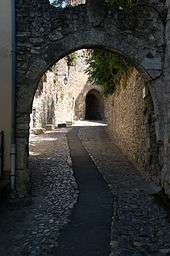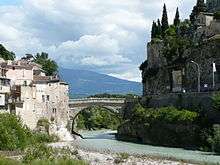Vaison-la-Romaine
| Vaison-la-Romaine | ||
|---|---|---|
|
Vaison-la-Romaine seen from high in the medieval upper town | ||
| ||
 Vaison-la-Romaine | ||
|
Location within Provence-A.-C.d'A. region  Vaison-la-Romaine | ||
| Coordinates: 44°14′32″N 5°04′21″E / 44.2422°N 5.0724°ECoordinates: 44°14′32″N 5°04′21″E / 44.2422°N 5.0724°E | ||
| Country | France | |
| Region | Provence-Alpes-Côte d'Azur | |
| Department | Vaucluse | |
| Arrondissement | Carpentras | |
| Canton | Vaison-la-Romaine | |
| Intercommunality | Pays Voconces | |
| Government | ||
| • Mayor (2014–2020) | Jean-François Périlhou | |
| Area1 | 26.99 km2 (10.42 sq mi) | |
| Population (2013)2 | 6,089 | |
| • Density | 230/km2 (580/sq mi) | |
| Time zone | CET (UTC+1) | |
| • Summer (DST) | CEST (UTC+2) | |
| INSEE/Postal code | 84137 / 84110 | |
| Elevation |
156–493 m (512–1,617 ft) (avg. 204 m or 669 ft) | |
|
1 French Land Register data, which excludes lakes, ponds, glaciers > 1 km² (0.386 sq mi or 247 acres) and river estuaries. 2 Population without double counting: residents of multiple communes (e.g., students and military personnel) only counted once. | ||
Vaison-la-Romaine (Latin: Vasio Vocontiorum) is a commune in the Vaucluse department in the Provence-Alpes-Côte d'Azur region in southeastern France.The French archaeologist and hellenist Henri Metzger (1912–2007) died here.
The historic section is in two parts, the Colline du Château on a height on one side of the Ouvèze, the "upper city" and on the opposite bank, the "lower city" centered on the Colline de la Villasse.
History

At Vasio Pompeius Trogus, the Augustan historian, was born.
The barbarian invasions were presaged by a pillaging and burning in 276, from which Roman Vasio recovered, but in the fifth century the benches of the theatre began to be reused as Christian tombstones. Vaison belonged the Burgundians, was taken by the Ostrogoths in 527, then by Clotaire I, King of the Franks in 545, and became part of Provence
The disputes which broke out in the twelfth century between the counts of Provence, who had refortified the ancient "upper town" and the bishops, each of whom were in possession of half the town, were injurious to its prosperity; they were ended by a treaty negotiated in 1251 by the future pope Clement IV, a native of Saint-Gilles-du-Gard.
At disturbed times of the Middle Ages, the inhabitants emigrated to the higher ground on the left bank of Ouvèze, with the shelter of the ramparts and a strong castle. From the eighteenth century most of the population had moved back down to the plains by the river.
A flood struck Vaison-la-Romaine on 22 September 1992, costing $1.5 billion in damages. It was the town's worst flood since 1632, and was featured in the Discovery Channel series Destroyed In Seconds.
Main sights
.jpg)
One of the most interesting aspects of the town is its geography, and its Roman ruins. The Roman ruins and the modern town are in the valley on the banks of the river Ouvèze which is crossed by an ancient bridge from the 1st century AD.
The medieval town is high on the rocky cliff. The valley floor was safe from attack in Roman and modern times. In the Middle Ages attacks were frequent, and the town retreated up-hill to a more defensible position.
The apse of the Church of St. Quenin, dedicated to Saint Quinidius, seems to date from the eighth century; it is one of the oldest in France.
As a whole the cathedral dates from the 11th century, but the apse and the apsidal chapels are from the Merovingian period.
At Vaison-la-Romaine, a street was named Impasse Alice Colonieu.
The town also has a famous open air market held on Tuesdays year round.[6]
Twin towns
 Martigny, Switzerland.
Martigny, Switzerland.
See also
Gallery
- Castle of the counts of Toulouse
 Ruins of a Roman villa
Ruins of a Roman villa Cloister Interior
Cloister Interior Narrow streets of the old town
Narrow streets of the old town Laureled Apollo house in Vaison-la-Romaine
Laureled Apollo house in Vaison-la-Romaine Roman bridge in Vaison la Romaine, France
Roman bridge in Vaison la Romaine, France
References
- ↑ The jurisdiction of the Roman civitas coexisted for some time with the Gaulish oppidum, according to Christian Goudineau.
- ↑ Christian Goudineau, Les fouilles de la Maison au Dauphin. Recherches sur la romanisation de Vaison-la-Romaine (Paris: CNRS) 1979
- ↑ There are sixty-nine, mostly fragmentary, noted in Henri Lavagne , Recueil général des mosaïques de la Gaule. Vol. 3.3 "Province de Narbonnaise, Partie sud-est".
- ↑ Julius S. Gassner, "The Roman Theater at Vaison-la-Romaine" The Classical Journal 61.7 (April 1966), pp. 314-317.
- ↑ British Museum Collection
- ↑ "The markets, a reflection of the Provencal identity".
Sources
- Rivet, A. L. F. '1988. Gallia Narbonensis: Southern Gaul in Roman Times, part II: "Civitates", (London: Batsford). A brief summary of the archaeology.
External links
| Wikimedia Commons has media related to Vaison-la-Romaine. |
-
 Vaison-la-Romaine travel guide from Wikivoyage
Vaison-la-Romaine travel guide from Wikivoyage - Vaison-la-Romaine official website
- The medieval town of Vaison-la-Romaine (in French and English)
- Association pour la Protection de la Haute Ville
- INSEE
.jpg)
.svg.png)